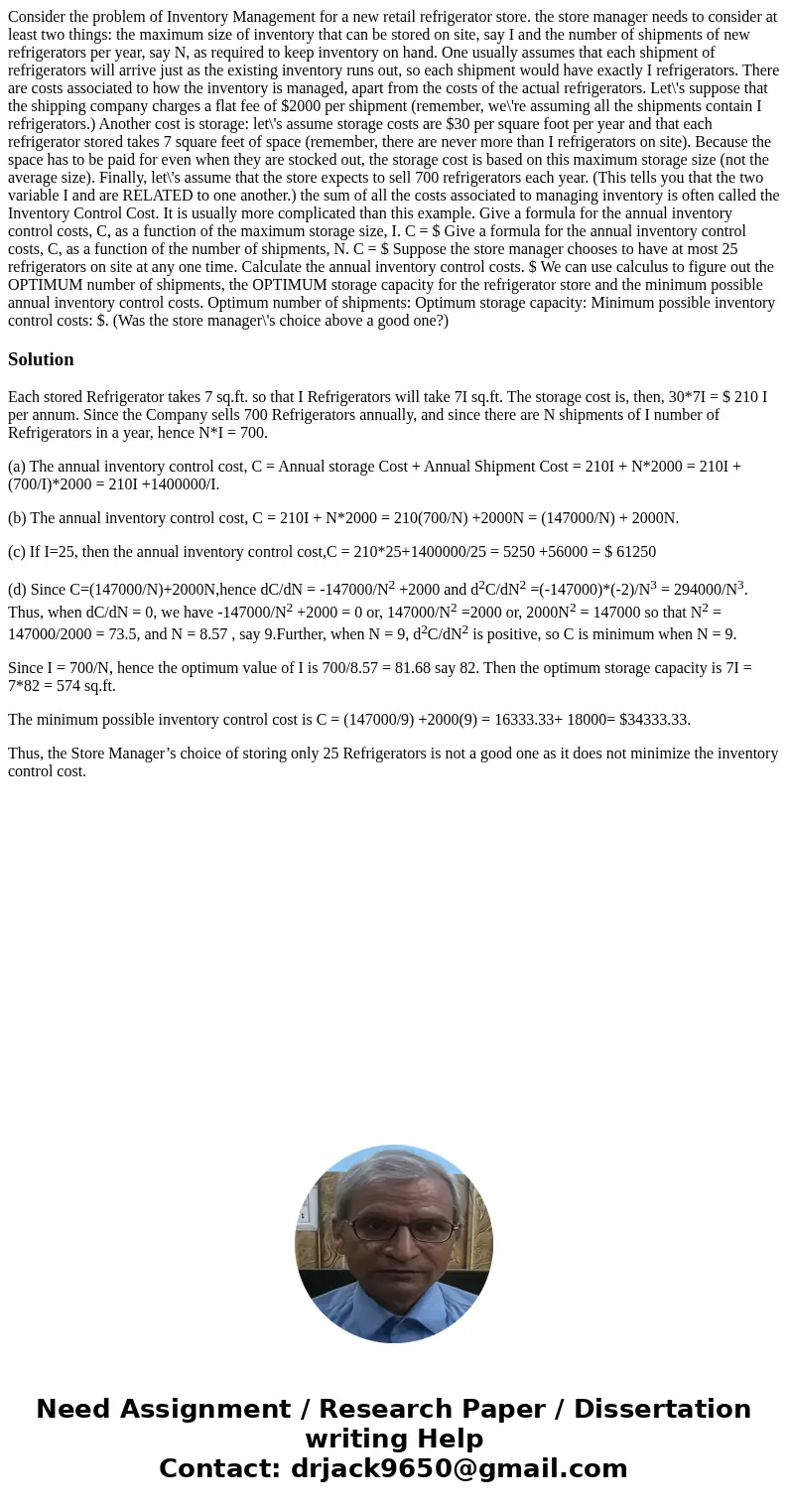Consider the problem of Inventory Management for a new retail refrigerator store. the store manager needs to consider at least two things: the maximum size of inventory that can be stored on site, say I and the number of shipments of new refrigerators per year, say N, as required to keep inventory on hand. One usually assumes that each shipment of refrigerators will arrive just as the existing inventory runs out, so each shipment would have exactly I refrigerators. There are costs associated to how the inventory is managed, apart from the costs of the actual refrigerators. Let\'s suppose that the shipping company charges a flat fee of $2000 per shipment (remember, we\'re assuming all the shipments contain I refrigerators.) Another cost is storage: let\'s assume storage costs are $30 per square foot per year and that each refrigerator stored takes 7 square feet of space (remember, there are never more than I refrigerators on site). Because the space has to be paid for even when they are stocked out, the storage cost is based on this maximum storage size (not the average size). Finally, let\'s assume that the store expects to sell 700 refrigerators each year. (This tells you that the two variable I and are RELATED to one another.) the sum of all the costs associated to managing inventory is often called the Inventory Control Cost. It is usually more complicated than this example. Give a formula for the annual inventory control costs, C, as a function of the maximum storage size, I. C = $ Give a formula for the annual inventory control costs, C, as a function of the number of shipments, N. C = $ Suppose the store manager chooses to have at most 25 refrigerators on site at any one time. Calculate the annual inventory control costs. $ We can use calculus to figure out the OPTIMUM number of shipments, the OPTIMUM storage capacity for the refrigerator store and the minimum possible annual inventory control costs. Optimum number of shipments: Optimum storage capacity: Minimum possible inventory control costs: $. (Was the store manager\'s choice above a good one?)
Each stored Refrigerator takes 7 sq.ft. so that I Refrigerators will take 7I sq.ft. The storage cost is, then, 30*7I = $ 210 I per annum. Since the Company sells 700 Refrigerators annually, and since there are N shipments of I number of Refrigerators in a year, hence N*I = 700.
(a) The annual inventory control cost, C = Annual storage Cost + Annual Shipment Cost = 210I + N*2000 = 210I + (700/I)*2000 = 210I +1400000/I.
(b) The annual inventory control cost, C = 210I + N*2000 = 210(700/N) +2000N = (147000/N) + 2000N.
(c) If I=25, then the annual inventory control cost,C = 210*25+1400000/25 = 5250 +56000 = $ 61250
(d) Since C=(147000/N)+2000N,hence dC/dN = -147000/N2 +2000 and d2C/dN2 =(-147000)*(-2)/N3 = 294000/N3. Thus, when dC/dN = 0, we have -147000/N2 +2000 = 0 or, 147000/N2 =2000 or, 2000N2 = 147000 so that N2 = 147000/2000 = 73.5, and N = 8.57 , say 9.Further, when N = 9, d2C/dN2 is positive, so C is minimum when N = 9.
Since I = 700/N, hence the optimum value of I is 700/8.57 = 81.68 say 82. Then the optimum storage capacity is 7I = 7*82 = 574 sq.ft.
The minimum possible inventory control cost is C = (147000/9) +2000(9) = 16333.33+ 18000= $34333.33.
Thus, the Store Manager’s choice of storing only 25 Refrigerators is not a good one as it does not minimize the inventory control cost.

 Homework Sourse
Homework Sourse